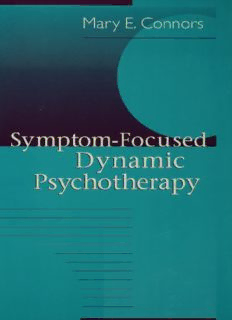
Symptom-Focused Dynamic Psychotherapy PDF
Preview Symptom-Focused Dynamic Psychotherapy
SYMPTOM-FOCUSED DYNAMIC PSYCHOTHERAPY Copyrighted Material Copyrighted Material SYMPTOM-FOCUSE DYNAMIC PSYCHOTHERAPY MARY E. CONNORS THE ANALYTIC PRESS 2006 Mahwah, New Jersey London CopyrightedMaterial © 2006 by The Analytic Press, Inc., Publishers All rights reserved. No part of this book may be reproduced in any form—by photostat, microform, retrieval system, or any other means—without the prior written permission of the pub- lisher. Published by The Analytic Press, Inc., Publishers Editorial Offices: 10 Industrial Avenue Mahwah, NJ 07430 www.analyticpress.com Designed and typeset by CompuDesign, Charlottesville, VA Library of Congress Cataloging-in-Publication Data Connors, Mary E., 1953— Symptom-focused dynamic psychotherapy / Mary E. Connors. p. cm. Includes bibliographical references and index. ISBN 0-88163-444-1 1. Psychodynamic psychotherapy. I. Title. [DNLM: Behavior Therapy. 2. Behavioral Symptoms—therapy. WM 425 C752S 2006] RC489.4.P72C66 2006 616.89'4—dc22 2005054550 Printed in the United States of America 10 9 8 7 6 5 4 3 2 1 Copyrighted Material FOR MY BROTHER, ROBERT J. CONNORS I951-20OO Copyrighted Material Copyrighted Material CONTENTS Preface and Acknowledgments ix Chapter 1 Rationale for a Symptom-Focused 1 Dynamic Treatment Chapter 2 Active Techniques in a Context of Integrative Possibility 24 Chapter 3 The Decision to Use Active Techniques 69 Chapter 4 Cognitive Interventions 95 Chapter 5 Behavioral Techniques 116 Chapter 6 Suggestions for Intervention with Specific Symptoms 150 Chapter 7 A Patient with Compulsive Behaviors 178 Chapter 8 A Patient with Generalized Anxiety 202 Chapter 9 A Patient with Binge Eating and Depression 218 Chapter 10 A Patient with a Relational Dilemma 240 References 265 Index 281 vit Copyrighted Material Copyrighted Material PREFACE AND ACKNOWLEDGMENTS MY EARLY BEHAVIORAL TRAINING EMPHASIZED that psychother- apy was something to "do." I learned a variety of active interven- tion strategies, implemented them, and assessed the outcome. My psychoanalytic training led me to think that perhaps therapy was more about how to be with someone rather than what to do (which was a relief, as I had little idea what I was supposed to do, and how and when to do it!) Yet I liked the idea of being as effec- tive as possible with the various problems that people brought to treatment, and it seemed that knowing some specific things to do at times might facilitate my ability to help. Gradually I began to develop a psychotherapeutic style that incorporated symptom- focused interventions into a dynamic treatment, and I found that such integration seemed coherent as I employed it with my patients. However, that is not what I was taught. When I began my graduate program in psychology in 1977, the available theoreti- cal paradigms were very different from current versions. The per- spectives with which I became most familiar—psychoanalytic and behavioral—were more distant from people's actual experience than is the case today as well as more at absolute odds with one another. The dominant psychoanalytic paradigm was drive the- ory, and the behavioral theory that I was taught focused prima- rily on classical and operant conditioning. I began seeing my first patients when I was a young graduate student, and they displayed some complex difficulties, including sexual fetishes, paranoid delu- sions, and desperate relationship seeking. I found the theories I knew to be disappointing in furthering my understanding of my ix Copyrighted Material
Description: